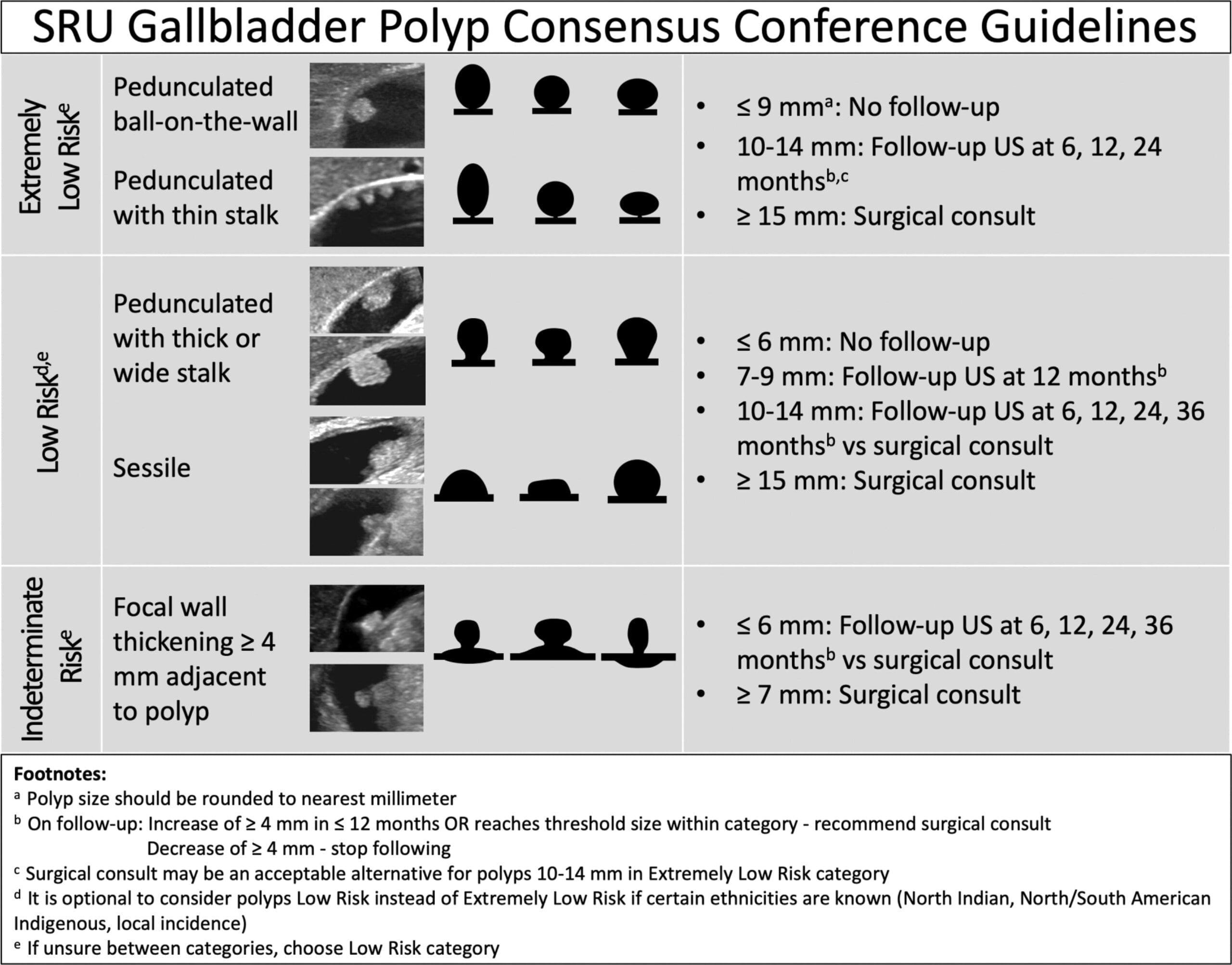Gallbladder polyp seen on ultrasound
Short interval follow-up US within 1-2 months with optimized grayscale, color Doppler technique, and patient preparation
Short interval follow-up US within 1-2 months with optimized grayscale, color Doppler technique, and patient preparation
CEUS or MR for further characterization
Referral to oncologic specialist
Refer to gastrointestinal specialty guidelines
Select the morphology of the polyp:
Impression:
- Round up polyp size to the nearest millimeter.
- On follow-up:
- Increase of ≥ 4 mm in < 12 months OR reaches threshold size within category - recommend surgical consult
- Decrease of ≥ 4 mm - stop following
- Surgical consult may be an acceptable alternative for polyps 10-14 mm in Extremely Low Risk category
- It is optional to consider polyps Low Risk instead of Extremely Low Risk if certain ethnicities are known (North Indian, North/South American Indigenous, local incidence).
- If unsure between categories, choose Low Risk category.

Incidental gallbladder polyps are one of the most common ultrasound findings, but their management has long posed a dilemma. The vast majority represent benign cholesterol deposits or inflammatory lesions. However, the lingering possibility of premalignant pathology has traditionally driven aggressive treatment with prolonged surveillance or surgical removal, even for tiny polyps.
The new consensus guidelines from the Society of Radiologists in Ultrasound (SRU), published in Radiology, provide a long-awaited, evidence-based framework to standardize management and avoid overtreatment of these frequent incidental polyp findings.
Risk Stratification and Follow-Up Recommendations
Central to the new SRU approach is stratifying polyps into three risk categories based on morphology, with different follow-up protocols and imaging recommendations for each group:
Extremely Low Risk: Pedunculated polyps 9mm or smaller with a thin stalk or "ball-on-the-wall" appearance require no follow-up ultrasounds whatsoever, based on their benign polyp imaging characteristics.
Low Risk: Sessile (broad-based) polyps or those with a wide stalk are considered slightly higher risk lesions. Those 6mm or smaller still don't require monitoring, but larger ones up to 14mm get periodic ultrasound exams at recommended intervals based on polyp size thresholds.
Indeterminate Risk: Polyps of any size associated with focal gallbladder wall thickening of 4mm or greater adjacent to the lesion are concerning for a potential mass and generally warrant surgical consultation and possible removal, especially if the polyp portion measures 7mm or larger based on polyp ultrasound features.
The guidelines recommend surgical referral for any polyp demonstrating rapid expansion, defined as growing ≥4mm within 12 months or reaching ≥15mm total size, regardless of initial morphology.
A key change is limiting routine follow-up imaging to a maximum of 3 years for most smaller, stable polyps under 15mm that aren't rapidly growing. Evidence shows if gallbladder cancer arises from a benign precursor, it tends to become evident within this timeframe, making prolonged monitoring of low clinical utility.
Emphasis on Evidence-Based Management
The comprehensive recommendations were developed by a multidisciplinary panel that conducted an exhaustive review of the latest gallbladder polyp literature. The authors emphasize these are guidelines, not absolute rules. Physician judgment considering individual patient risk factors and shared decision-making remains paramount, especially for higher surgical risk patients.
But the comprehensive algorithms provide a standardized framework using polyp morphology and growth patterns to gauge which lesions merit surveillance versus intervention.
Benefits of the New Approach
By allowing most subcentimeter polyps with benign imaging features to forego prolonged monitoring based on the extremely low cancer risk, the new approach aims to provide reassurance while avoiding overtreatment that has become commonplace.
At the same time, it advocates appropriate triage for polyps exhibiting worrisome characteristics like large size, rapid expansion, or concerning wall thickening based on surgical consultation guidelines.
For higher risk groups like those with primary sclerosing cholangitis, the authors defer to specialty society recommendations rather than the polyp guidelines.
As the field evolves, the evidence-based SRU consensus guidelines may be revised. But the multidisciplinary recommendations represent a major step towards increasing consistency, quality, and value in managing one of radiology's most common incidental findings.
FAQs
Q: Do all gallbladder polyps need surgical removal per the guidelines?
A: No, most small polyps under 1cm with benign imaging features can be safely followed with periodic ultrasound or ignored completely in extremely low risk cases.
Q: What polyp characteristics should prompt surgical removal?
A: Surgical consultation is recommended for high risk polyps ≥15mm, or those under 15mm with rapid growth (≥4mm expansion within 12 months).
Q: How often should small polyps get imaged?
A: Most stable polyps under 15mm only require monitoring for 3 years maximum, as evidence shows cancer from benign precursors tends to manifest within this timeframe. Follow up can be at 6 or 12 months interval. You can use the recommendation tool above for the recommendation guidelines.
Q: What if a polyp is associated with wall thickening?
A: Any polyp with ≥4mm adjacent focal wall thickening is considered indeterminate risk and generally warrants surgical evaluation, especially if the polyp portion is ≥7mm, due to concern for an underlying mass.
Check out other radiology useful calculators:
Radiology Calculators
Watch this detailed video regarding SRU recommendations for Gallbladder polyp surveillance
Disclaimer: The author makes no claims of the accuracy of the information contained herein; this information is for educational purposes only and is not a substitute for clinical judgment. This tool is not affiliated or verfied by the SRU.
References:
- Management of Incidentally Detected Gallbladder Polyps: Society of Radiologists in Ultrasound Consensus Conference Recommendations. Aya Kamaya, Christopher Fung, Jean-Luc Szpakowski, David T. Fetzer, Andrew J. Walsh, Yewande Alimi, David B. Bingham, Michael T. Corwin, Nirvikar Dahiya, Helena Gabriel, Walter G. Park, Matthew R. Porembka, Shuchi K. Rodgers, Mitchell E. Tublin, Xin Yuan, Yang Zhang, and William D. Middleton
